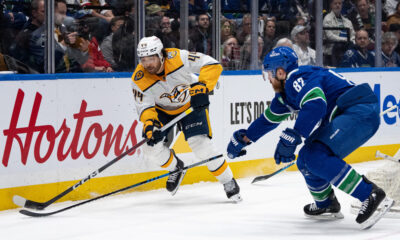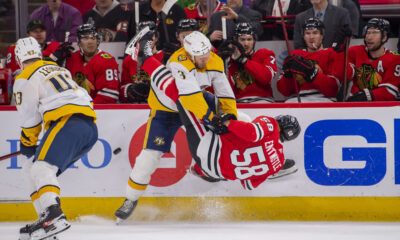As the 2016 NHL Draft in Buffalo swiftly approaches, it seems like a good opportunity to reflect on draft days gone by. Specifically, l’d like to take a moment and look back at the successes of each NHL franchise and grade their performance.
In order to do this, I partnered with my analytics wiz kid brother, who has a beautiful mind when it comes to analyzing trends in data. Jon has worked tirelessly developing a formula to produce a metric roughly approximating the “success” of a player at the NHL level in order to analyze which teams have been successful and unsuccessful at drafting.
Editorial note: the numbers below do NOT include this year’s statistics due to the data becoming corrupt when it was being updated. All data is calculated using statistics from 1998-2015. Also, I take no credit for any of the data below. This is my brother’s (Jon Rydburg) work and he deserves full marks for it. You can follow him at @jryd9
Looking back at the 1998-2007 NHL draft years
Some franchises, such as the Detroit Red Wings, have a reputation as draft winners because their prospects seemingly always mature into NHL caliber talent, while others, such as the Edmonton Oilers, are only able to win draft lotteries. Without numerical support, these perceptions are based off of only a few anecdotal examples, but a deeper dive can reveal what teams truly are better on draft day.
I looked at every pick made in the drafts between 1998 and 2007 to limit the sample to players who have had time to sink or swim at the NHL level, but were picked recently enough to be relevant but This is also the Nashville Predator’s first decade in the league, a critical time in the franchise’s history. I wanted to see how the Preds stacked up against the rest of the league in their earlier years.
One Excel file with 2640 players later, here is what I found:
The “success difference” method
I won’t bore you with all the intricate details, so here are the highlights:
• I created a (lengthy) formula to calculate “success” of each pick using GP per Year since Draft and a quality metric (PPG for F, TOI/G for D, SV% for G). The highest possible success rating is 100 and a player who never made the NHL has a success rating of 0.
• Using both the mean for each pick and a logarithmic regression line, I calculated how far above or below average for that specific pick a player performed. I call this “success difference”
• I then averaged the “success difference” of every pick for each team to see who did the best.
For reference, here are the players with the top 15 success ratings (the top individual success difference ratings are covered later):
Now, I know what you’re thinking. Jay Bouwmeseter ahead of Patrick Kane? Yes, this may not be perfect, but it’s close enough to give us a good idea of how different teams have done. There is no arguing that JBo, who has been a top pairing defenseman for a decade, has had success at the NHL level.
Team draft results
Each team’s average success rating across all positions and rounds is shown on the chart below. The team with the most successful picks relative to the average performance of everyone else taken at that pick was Montreal. The team that performed the worst was the (now re-named) Arizona Coyotes.
Top 15 NHL teams
Bottom 15 NHL teams
Montreal and San Jose formed a strong top two, clearly ahead of the rest of the pack. The best picks for the Sharks in this era, with their corresponding success difference ratings, were Marc-Edouard Vlasic (58.09), Christian Ehrhoff (44.14), Matt Carle (43.67) and Joe Pavelski (39.24).
Montreal’s high score was fueled by great picks such as Mark Streit (53.29), Jaroslav Halak (47.47) and Andrei Markov (43.60).
Note, these players were not necessarily the most successful pick by each team, but were the picks that performed the highest above the average player taken at their exact draft position.
On the negative side, Arizona, Florida and Tampa performed very poorly in this decade. The two worst picks for each team were Patrick DesRochers (-21.48) and Jakub Koreis (-19.00) for the Yotes, Denis Shvidki (-23.5) and Petr Taticek (-23.05) for the Panthers and Alexander Svitov (-37.04) and Nikita Alexeev (-18.83) for the Bolts.
Obviously, the Bolts have been able to greatly improve their drafting over the last few years, adding Kucherov and Palat in the later rounds.
While viewing all of the data at once is interesting, we can dive deeper. For instance, let’s examine what teams performed the best when only players of a certain position are taken into account.
It is pretty easy to see how Arizona ended up with the worst score of the decade, since they were in the bottom three at all three positions. Montreal, on the other hand, was in the top five in each case. Keep in mind that while all picks at all positions have success difference scores that sum to zero, this is not true of individual positions.
Across the board, defensemen and goalies were above average, while forwards were below average for their picks. Defensemen and goalies are statistically more successful in later rounds when the potential for a very high success difference score is greater.
It’s also compelling to see how different teams performed in each individual round.
Top NHL teams
Bottom NHL teams
Philadelphia was deadly in the first round during this decade, picking players with positive success difference ratings with eight of their ten picks (Giroux, Richards, Carter, Williams, Gagne, Pitkanen, Downie and Woywitka). Headlining this group is star center Claude Giroux, who scored a 40.728.
The Bolts and Rangers, however, didn’t fare so well.
Tampa only had six first rounders in this decade and five of them were negative, with Svitov (-37.04) being the worst culprit. Only Lecavalier was positive, a first overall selection in 1998.
The Rangers had an astounding 9 negative picks out of 10 in the first round, with Pavel Brendl (-30.17) being the worst. Only Marc Staal beat the average for his pick (29.58).
Which teams drafted best from certain regions of the world?
I broke the countries that had a good chunk of draftees into North America, the Russian Block (Russia and Belarus), established European hockey countries (Sweden, Finland and Czech) and emerging European hockey countries (all other Euros).
There were a few other countries that produced NHL picks in this time period, but their sample sizes were too small to produce meaningful data. In fact, the country with the highest average player difference rating is Brazil because Robin Regehr is the only player ever drafted from there.
As you can see below, the best performing region was the established portion of Europe.
Whoever was Montreal’s Russian scout in this decade needs a bonus. That area of the world was a whopping -2.95 on average, but Montreal managed to score a 9.18. They drafted four NHL regulars from this region: Andrei Markov, the Kostitsyn brothers, and Alexei Emelin. They were also in the top three in North America and emerging Europe.
On the macro level, it is worth noting that at least in this decade, the infamous “Russian factor” is supported by data. In part due to lower GP ratings after some players left for the KHL, Russian block players posted objectively worse success ratings.
NHL player breakdown
For an even more comprehensive view on how players stacked up against their peers, I divided up each player by position to get the top 10.
In order to determine ranking, I compared them to players taken at the same point in the draft.
Here are the top and bottom 10 players across all positions.
Note that the Red Wings’ two franchise forwards are the only two forwards in the top ten, while the Rangers managed to make two of the seven worst selections. One key observation to take away from these numbers is drafting a forward in the first round is always preferable to taking a defenseman or goalie.
What is the value of a NHL draft pick?
After all this data crunching, I wanted to give a visual presentation on how much each pick is really worth.
First up, this is a plot of the success of every single player taken between 1998 and 2007 vs. the pick where they were selected. As previously stated, there are 2640 players represented on this chart.
The highest point at 100 success is Crosby. The really high point around pick 200 is Lundqvist at pick #205.
If it looks like the quality of players isn’t dropping that much, it’s because you can’t see just how many players are busting completely in the later rounds. The best players taken here are still good, but as you move forward in the draft, it becomes very rare that a player sticks in the NHL at all.
This graph emphasizes that point. It shows the average success of each pick vs. the pick number. The value on the y-axis here is the average success of all players picked at this position.
Finally, a logarithmic regression line (R-square of just over .88) of the average success of each pick.
Key lessons learned from this project
- Never trade a top three pick
- Avoid defensemen and goalies in the first round
- There really is no difference between a 5th and 7th rounder
- The middle and late rounds really separate the winners from losers
What about the Nashville Predators’ draft success?
As you can see, the Nashville Predators fell right in the middle of the NHL (-.032). They had great success in the first round, but ultimately suffered in the middle rounds in the early years.
This trend, however, would change over the next few years as the Preds were unable to score successful first round selections in Colin Wilson (objectively for his draft position), Chet Pickard, Austin Watson and (so far) Seth Jones but found success in the middle rounds with Roman Josi, Craig Smith and Mattias Ekholm.
What does the 2016 NHL Draft hold in store for the Nashville Predators? Watch on Friday, June 23rd to find out.
Keep reading Penalty Box Radio to find out more draft coverage!

























